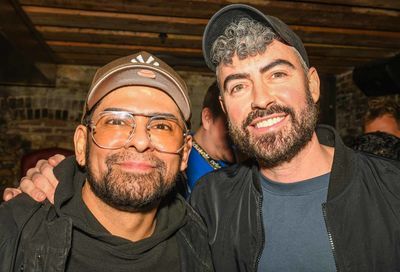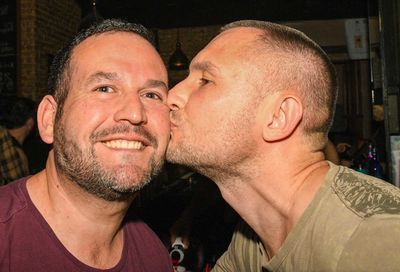HRW: To curb anti-transgender violence, address the issues making trans people vulnerable
Human Rights Watch releases report on anti-transgender violence, its root causes, and government's obligations to protect trans people.

Ahead of the annual commemoration of the Transgender Day of Remembrance, a human rights watchdog released a report highlighting the violence and harassment facing transgender people in the United States, looking the factors that contribute to an atmosphere of hostility towards the trans community and making recommendations for how to prevent that violence.
In a 65-page report, “‘I Just Try to Make It Home Safe’: Violence and the Human Rights of Transgender People in the United States, Human Rights Watch documents how persistent marginalization, poverty, and a limited amount of opportunities put transgender people, particularly Black transgender women, at heightened risk of violence at the hands of strangers, partners, family members, and law enforcement.
The report is based on interviews with more than 60 transgender people who had experienced violence, advocates, and service providers who work with trans victims of violence, as well as data on anti-transgender discrimination and violence in the United States. The bulk of the interviews were conducted in Florida, Ohio, and Texas, where higher numbers of transgender individuals have been killed in recent years.
“We set out to do a project looking at the nature of the violence that trans people experience and what some of the compounding factors are that exacerbate that violence,” Ryan Thoreson, a researcher at Human Rights Watch who worked on the report, told Metro Weekly in an interview. “What we found was that there’s a lot of attention given to fatal violence when that occurs, but that people often experience other forms of violence that go unreported and unrecorded, like intimate partner violence, family violence or violence from law enforcement officials.
“There’s a couple of different factors that exacerbate vulnerability that came out repeatedly in the interviews, particularly socioeconomic vulnerabilities,” he added. “People mentioned that when they lived in poverty, they often were limited in their ability to leave situations where they felt like they were in danger. Trans people have high rates of homelessness, and when people had insecure housing or were relying on maybe a dangerous living situation to have someplace to stay, it also put them at a greater risk of violence.
“Some interviewees mentioned, ‘When I didn’t have access to gender affirming health care and people could “clock me” as trans in public, that was when I felt most at risk, and felt like people might attack me or people would threaten me or ask me intrusive questions,’ like on public transportation,” Thoreson added.
He noted that a lack or limited amount of accessible gender-affirming resources for transgender people can put them at risk of violence and harassment, either because they remain in silence and never seek help, or because when they do attempt to access support services, they feel shunned or discriminated against because of their gender identity
“People mentioned that there was maybe one homeless shelter in their area that was inclusive of trans people, or they didn’t feel like they could use domestic violence services, or, in one instance, I spoke to a woman who said ‘When I called the police and said that my partner assaulting me, you know, they didn’t take it seriously because I’m bigger than he is.’ So things like that also put people at risk because they do experience violence, they may not have anywhere to go that’s affirming of trans people,” Thoreson said.
A review of cases of fatal violence from 2016 to 2021 also shows how anti-transgender violence is often intersectional, with at least 88% of transgender victims in Florida, and more than 90% of victims in Ohio and Texas being people of color.
Related: Almost half of all transgender Southerners say they experience “high levels” of violence
The absence of nondiscrimination laws may also play a role in exacerbating a transgender person’s level of vulnerability. Currently, only 21 states expressly prohibit discrimination on the basis of gender identity in employment, housing, and public accommodations.
Thoreson said that the absence of nondiscrimination protections can simply make it harder to find employment and thrive financially.
“When people don’t have employment that they can pursue as their authentic selves, it really limits the rest of their options. It’s the same with with housing and health care and other demands,” he said. “We know that a lot of trans women in particular engage in sex work often because they don’t feel like they have other employment opportunities, and that is a place where their work is criminalized and they’re subject to a lot of violence from clients, but also sometimes from law enforcement as well.”
While the Biden administration has attempted to address anti-transgender discrimination at the federal level, lawmakers, particularly in Republican-led states, have introduced and, in some cases, even passed bills that chip away at existing protections for LGBTQ and specifically transgender individuals. Some of the interviewees in the Human Rights Watch study cited those hostile efforts one of the factors contributing to fears about their safety in public spaces. And while progress on protections for trans people at the federal level is always welcome, it often takes time and shifting cultural attitudes to ensure those laws or protections are guaranteed at the state or local level.
“That was something we consistently heard about with regard to housing, that it’s great that the federal government is being more proactive about prohibiting anti-trans discrimination in homeless shelters,” Thoreson noted. “But that’s of limited utility if the other residents or transphobic or the staff aren’t trained and consistently misgender people. So nondiscrimination laws are a very basic first step. But there needs to be resources and energy put into public education and making those laws real and enforceable.”

The report also contains recommendations for ways to better address or prevent violence against transgender people.
“One of the big things that we emphasize in the report is that under international human rights law, governments don’t only have an obligation to kind of leave people alone and not abuse or torture them. They also have an obligation to protect citizens from foreseeable threats of violence,” Thoreson said. “When groups like transgender people are subject to regular violence, the state also has an obligation to intervene and to ensure that they take that violence seriously.
“We want the federal government to live up to its obligation to take proactive steps to to ensure that trans people are protected. There are also positive obligations under international human rights law, where the Universal Declaration of Human Rights and other human rights instruments say that the people should enjoy a kind of baseline level of social and economic welfare,” he added. “For trans people, who have really high rates of poverty and unemployment and housing insecurity, the federal government should be doing more to ensure that their basic needs are met. And that means nondiscrimination laws or means job training programs, housing vouchers, things like that. Governments need to step up to the plate.”
In order to curb anti-transgender violence, governments would be better suited addressing the root causes of systemic or societal issues that contribute to or exacerbate vulnerability, such as poverty, unemployment housing instability, lack of resources, and insufficient training for public servants on how to deal with and treat transgender people equitably. Even things that aren’t typically thought of as relating to violence, but that give transgender people the resources to allow them to extract themselves from potentially unsafe environments — such as having enough money to take a cab or an Uber home on a late night rather than relying on public transportation — can be part of a more comprehensive anti-violence strategy, Thoreson noted.
“When we take steps to protect trans people who are most vulnerable — and whether that means decriminalizing sex work, or enacting nondiscrimination laws, or addressing some of the more extreme poverty and housing insecurity — that tends to benefit everyone,” he said. “These are these are things that put people in general at risk of violence. And so when we’re addressing the conditions that trans people of color are at risk, we’re addressing problems that put everyone at risk.”
See also:
D.C. corrections officer says he was harassed and threatened at work because he’s gay
Oregon man accused of using Grindr to attack gay man and beat him with a wooden club
Support Metro Weekly’s Journalism
These are challenging times for news organizations. And yet it’s crucial we stay active and provide vital resources and information to both our local readers and the world. So won’t you please take a moment and consider supporting Metro Weekly with a membership? For as little as $5 a month, you can help ensure Metro Weekly magazine and MetroWeekly.com remain free, viable resources as we provide the best, most diverse, culturally-resonant LGBTQ coverage in both the D.C. region and around the world. Memberships come with exclusive perks and discounts, your own personal digital delivery of each week’s magazine (and an archive), access to our Member's Lounge when it launches this fall, and exclusive members-only items like Metro Weekly Membership Mugs and Tote Bags! Check out all our membership levels here and please join us today!




























You must be logged in to post a comment.